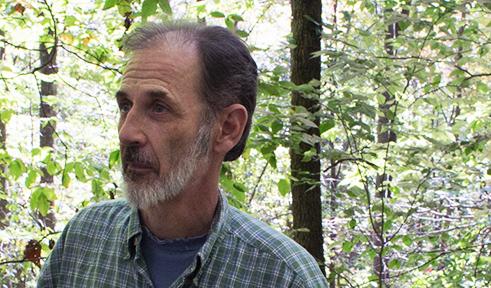
Professor of Environmental and Plant Biology
Porter 405, Athens Campus
Education
Ph.D. University College of North Wales, Bangor, UK 1984
Research
Faculty Research Focus Area: Eastern Deciduous Forest Ecology
Current and Recent Student Research Projects
- Roadside tree microclimate and pavement effects
- Interactions of plant mobility, habitat turnover, and habitat spatial structure (modeling)
- Long-term impacts of land use in forests of SE Ohio
- Urban Forests: Effects of street trees on urban microclimate and hardscape
- Plant invasions as a community assembly process
- Interactions of clonal growth and local environmental heterogeneity
- Dispersal of forest herbs by animals
Courses
College of Arts and Sciences Outstanding Teaching Award 2008
- PBIO 1090 Americans and their Forests
- PBIO 4350/5350 Plant Population Biology
- PBIO 3220/5220 Tropical Ecology
Departmental Service
- Department Promotion and Tenure Chair
- College of Arts & Sciences Curriculum Committee
- Faculty Senator
Professional Service
- Associate Editor, Journal of Ecology
- Biodiversity Management Planning, Wayne National Forest
Selected References
- Monsted J and GR Matlack. 2023. Human ecology of forest in an extraction-shaped landscape: Economic and demographic drivers of land use change in the Ohio Valley over 220 years. Regional Environmental Change, 23:101
- Matlack, G.R., I. Khoury, B. Naik. 2022. Tree canopy macrostructure controls heating of asphalt pavement in a moist-temperate urban forest. Urban Ecosystems, 25, pages 967–976.
- Monsted J and GR Matlack. 2021. Shaping the second-growth forest: fine-scale land use change in the Ohio Valley over 120 years. Landscape Ecology, in press .
- Glick, M.D. and GR Matlack2020. Tree-base microsites contribute to physical heterogeneity and herb community structure in a temperate-deciduous forest . Journal of Vegetation Science, online .
- Holmes MA and GR. Matlack. 2019. Non-native plant species show a legacy of agricultural history in second-growth forests of southeastern Ohio. Biological Invasions , 21, 3063–3076.
- Holmes MA and GR. Matlack. 2019. Spatial structure develops early in forest herb populations, controlled by dispersal and reproductive schedule . Oecologia 189: 951-970.
- Redwood, M.E. G.R. Matlack, and C.D. Huebner. 2019. Seed longevity and dormancy state in an invasive tree species: Ailanthus altissima. Journal of the Torrey Botanical Society, 146(2): 79–86.
- Redwood, M.E. G.R. Matlack, and C.D. Huebner. 2018. Seed longevity and dormancy state in an invasive tree species: Ailanthus altissima. Journal of the Torrey Botanical Society, in press. DOI not available yet. A copy will be provided on request.
- Holmes, M.A. and G.R. Matlack. 2018. Assembling the forest herb community after abandonment from agriculture: long-term successional dynamics differ with land-use history . Journal of Ecology, 106:2121–2131.
- Redwood, M.E., G.R. Matlack, and C.D. Huebner. 2018. Seed longevity and dormancy state suggest management strategies for garlic mustard (Alliaria petiolata) and Japanese stiltgrass (Microstegium vimineum) in deciduous forest sites . Weed Science, 66: 190-198
- Holmes, M.A. and G.R. Matlack. 2017. Forest structure develops through time: physical and biotic heterogeneity following abandonment from two forms of agriculture . Forest Ecology and Management, 404: 55-64.
- Niederhauser EC and G.R. Matlack 2017. Secondary dispersal of forest herb seeds from raccoon dung: Contrasting service by multiple vectors . Plant Ecology, 218: 1135-1147
- Holmes, M.A. and G.R. Matlack. 2017. Agricultural history drives structure and tree-species composition of second growth forest over 100 years in southeastern Ohio, USA . Journal of Vegetation Science, 28: 736–746.
- Niederhauser, E.C. and G.R. Matlack 2017. Do deer and raccoons defecate in the right place? Fitness consequences of vertebrate seed dispersal for a deciduous forest herb. Oecologia, 183: 727-737
- Holmes, M.A. and G.R. Matlack. 2017. Forest structure develops through time: physical and biotic heterogeneity following abandonment from two forms of agriculture. Forest Ecology and Management , in press.
- Niederhauser EC and G.R. Matlack 2017. Secondary dispersal of forest herb seeds from raccoon dung: Contrasting service by multiple vectors. Plant Ecology , in press.
- Matlack G.R., Naik B., Khoury I., Sinha G. 2016. Trees and pavement: a review of the effect of roadside trees on pavement performance and driving condition. Report to the Ohio Department of Transportation; Dec. 8, 2016. 54 pages.
- Redwood, M.E., G.R. Matlack, C.D. Huebner. 2016. Seed longevity and dormancy state in a disturbance-dependent forest herb, Ageratina altissima . Seed Science Research, 26: 148 – 152
- Niederhauser, E.C. and G.R. Matlack. 2016. Do deer and raccoons defecate in the right place? Fitness consequences of vertebrate seed dispersal for a deciduous forest herb. Oecologia, in press.
- Niederhauser, E.C. and G.R. Matlack. 2015. All frugivores are not equal: Exploitation competition determines seed survival and germination in a fleshy-fruited forest herb. Plant Ecology , in press .
- Matlack, GR. 2015. Managing fire in the mesic deciduous forest when fire history is unknown: response to Stambaugh et al. Conservation Biology , 29: 947-949.
- Schweizer, P.E. and G.R. Matlack. 2014. Factors driving land use change and forest distribution on the outer coastal plain of Mississippi, USA. Landscape and Urban Planning , 121: 55–64.
- Matlack, G.R. 2013. Reassessment of the use of fire as a management tool in deciduous forests of eastern North America. Conservation Biology , 27: 916-926.
- K.E. Hougen and G.R. Matlack. 2012. Long-term effects of land use history on species composition in post-industrial forests of southeastern Ohio, USA. Forest Ecology and Management, 269: 279–292.
